Maarel Orchids reduces the number of hours lights are needed by making smart use of temporary coatings
In 2020, orchid crop manager Johan Langelaan of Maarel Orchids explored his options for reducing the number of hours additional lighting would have to be used in his greenhouse, without compromising the amount of light his crop would get. Lumiforte consultant Paul van Gils told him he could try combining ReduFuse IR and ReduHeat. ‘Well-dosed use of multiple layers keeps heat out and allows more daylight to enter than ReduSol would,’ the manager said, having used the combination for three years now. ‘As a result, we don’t have to have the lights on for as long as we used to, and we conserve a lot of energy.’
In the past, Langelaan would apply one single layer of ReduSol to the greenhouse roof. This temporary coating does a good job of keeping out heat but also allows less light to penetrate the greenhouse. “So you would always have to keep the lights on for several hours, to make sure that the plants received enough light to grow, ”the crop manager told us. “We were wondering if there might be a smarter solution, because while energy prices were low in 2020, but for how much longer?”
Keeping heat out while maintaining high light levels
Langelaan put his question to Lumiforte consultant Paul van Gils. In addition to ReduSol, Lumiforte’s range offers several other types of coating, each with specific effects. Paul suggested switching to two different types of coating, which are applied to the glass on top of each other at different times,’ he said. “By using ReduFuse IR and ReduHeat, we’d keep out as much heat as with ReduSol, while losing far less light. As a result, we’d need less additional lighting, and we’d reduce our energy consumption. As a bonus, we’d be able to utilize two separate layering strategies for warm and cool sections.”

Orchid crop manager Johan Langelaan, Maarel Orchids
One layer of ReduFuse IR, followed by some ReduHeat
The new layering strategy involved applying a thin initial layer of ReduFuse IR coating to the entire greenhouse in the first half of February. This type of coating allows less infrared light (i.e. heat) to pass through and diffuses the PAR light that get transmitted. The diffusion [AKS1] ensures an even level of light when the movable screens are partly closed. ‘You don’t see the typical lighter and darker section under the screen, which is exactly what you want for uniform growth. We don’t have diffuse glass in our greenhouse, so ReduFuse IR is a good alternative.’
In or around Week 17 or 18 (depending on the weather conditions), an additional, thick layer of ReduHeat is applied to the cool sections. This product, too, reduces the amount of heat that enters the greenhouse but does facilitate a high level of light transmission. In or around Week 22 or 23, a second layer of ReduHeat is applied.
The three consecutive layers of coating protect the cool sections from excessive heat radiation, while allowing much more PAR light to enter the greenhouse than ReduSol would. “Between May and September, we reduce our need for additional lighting by a few hundred hours,” said the orchid grower.
No negative effect on the quality of the plants
According to Langelaan, the plants barely notice this new method of using layered coatings. “The greenhouse climate is virtually the same” he said. When using ReduHeat, the temperature of the plants is slightly lower than when using ReduSol, but since additional cooling in the form of air treatment is needed in both cases, that effect is canceled out. We have not noticed any difference in the amount of time it takes for crops to grow, or in the quality of the products.’
Profitable investment
Do growers conserve enough energy to break even, given the higher costs associated with this layering strategy? After all, when this method is used, more layers must be applied, which requires more coating and more man-hours. Needless to say, we performed all the calculations beforehand, and the orchid cultivation specialist replied, “We generate most of our power ourselves, using combined heat and power. In 2020, we were operating on the premise that gas would cost 15 cents per cubic meter. Assuming prices would remain at that level, we would earn back the higher costs 1.5 times in a sunny summer, and as much as three times in a dark summer. So it was a no-brainer. And at the current gas prices, the reduction in energy consumption we are realizing is having an even greater financial impact. So we’re thrilled that we can keep our lights off for longer, while the crops don’t suffer in the slightest.”


